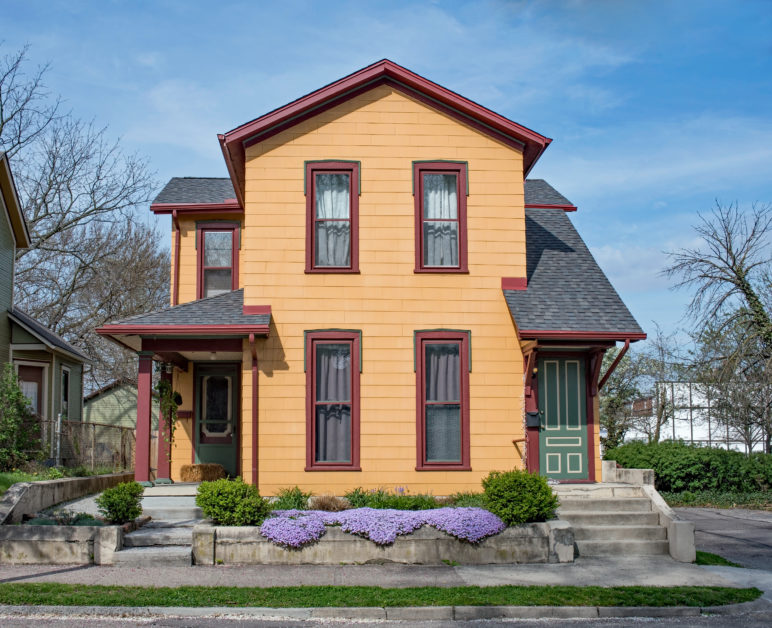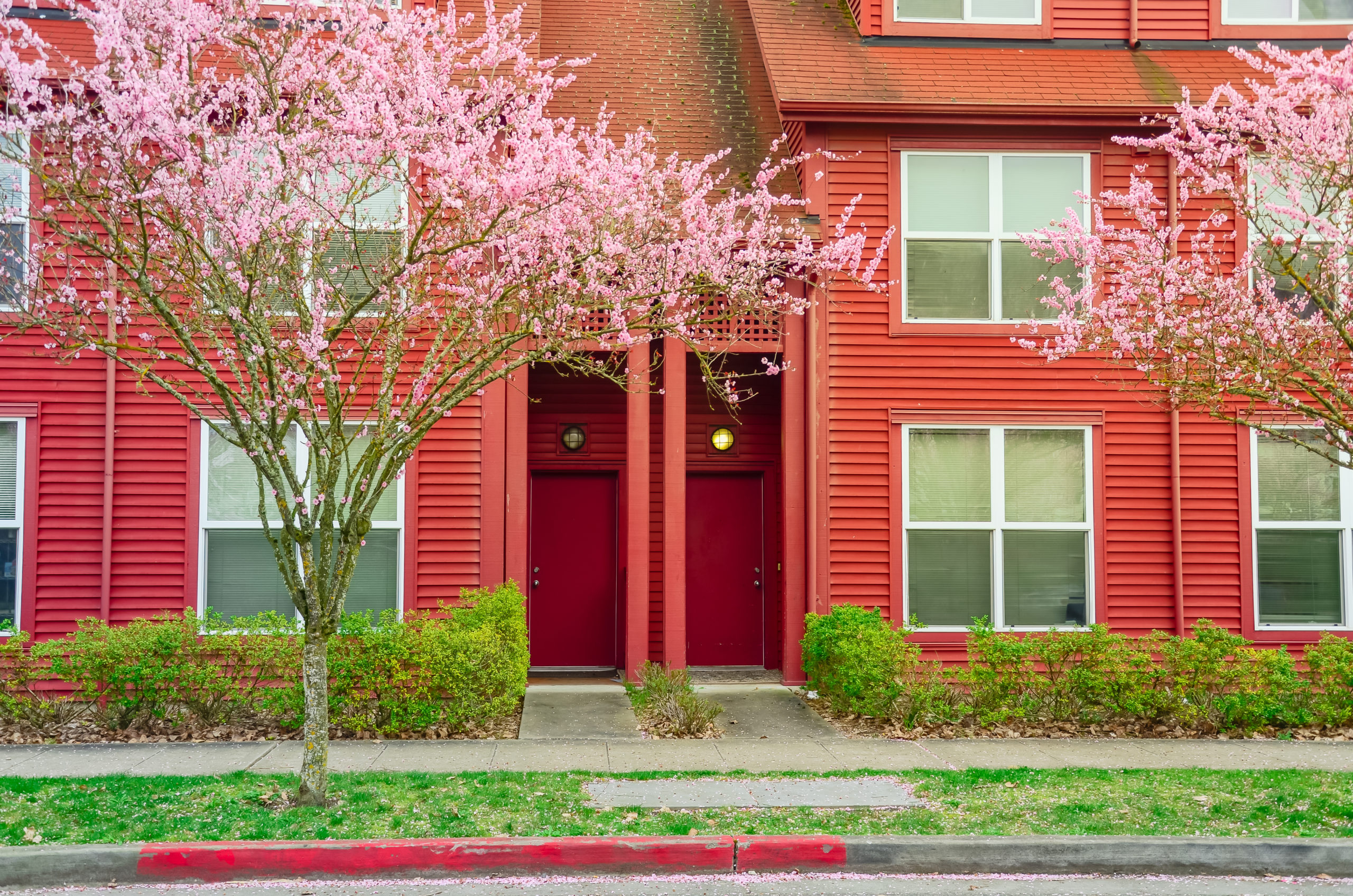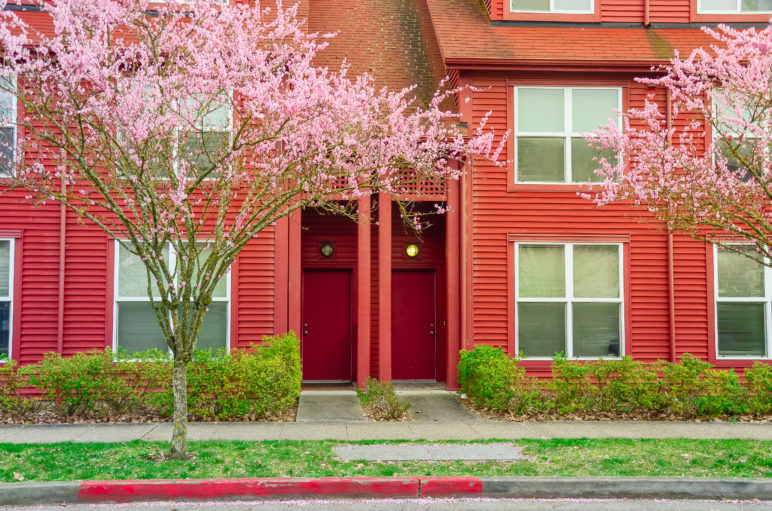President Donald Trump has launched single-family zoning onto the national stage. Fearmongering about “destroying the suburbs” is nothing new, but it typically plays out on local stages, where wealthy homeowners show up at city council meetings to thwart affordability measures such as lifting apartment bans—common municipal zoning restrictions on building cheaper homes like duplexes and apartments.
Meanwhile, momentum has been building for federal action on zoning laws that shut out poor people by banning modest, multi-dwelling homes. In May, the The New York Times editorial board got right to the point:
The government also should require communities that want federal funding for roads and other infrastructure to allow the development of denser, more affordable housing.
Last year US lawmakers introduced four bills with schemes to connect federal funding to zoning reform. Two of those—the YIMBY Act, and the Build More Housing Near Transit Act—are still in play in Congress. The HOME Act mirrors proposals made by several presidential primary candidates. The boldest of the four bills by far—the Place to Prosper Act—hasn’t moved beyond its introduction.
The pandemic and its economic fallout have laid bare the widespread, dire shortage of homes people can afford. Millions who’ve lost income are struggling to pay rents and mortgages driven sky high by scarcity. Congress’ best near term response is rental assistance, for example, as proposed for $100 billion in the HEROES Act passed by the House in May, but so far rejected by Senate Republicans.
Over the longer term, the essential and complementary second pillar of the solution is to legalize abundant housing, a move which addresses the core problem: a lack of homes driving up rents. And the federal government’s funding muscle gives it unique power to make that happen.
Bipartisan support is—dare I say—conceivable, notwithstanding the current dizzying heights of national divisiveness. What might it look like for Congress to make it happen?
Not only are big houses on big lots the most expensive kinds of homes, but they also constrain how many people can live near good jobs, schools, and parks. The squeeze drives prices up, and pushes low-income families out.

The case for federal action to phase out zoning that segregates
One of the main reasons housing costs have been spiraling out of reach for more and more North Americans is that most cities ban everything but stand-alone houses on most of their land. Not only are big houses on big lots the most expensive kinds of homes, but they also constrain how many people can live near good jobs, schools, and parks. The squeeze drives prices up, and pushes low-income families out.
Policymakers who invented “single-family zoning” in the 1920s saw this exclusionary outcome as a feature not a bug—the prevalent motivation was to keep out African Americans. To this day, restrictive zoning laws continue to discriminate against poor people and segregate cities.
With two recent exceptions—Minneapolis and Portland, Oregon—zoning’s lockdown on homes has proven largely immune to local efforts to undo it. Reform at the state-level holds more promise, as demonstrated by numerous laws passed in California, and most dramatically by Oregon’s legalization of duplexes and triplexes last year. But in most states, the political challenges remain formidable.
Federal incentives (or deterrents) have unmatched potential to tackle the country’s housing crisis at scale. Eliminating discriminatory zoning laws would also start to correct for the federal government’s historic role in causing racial segregation and robbing Black families of the generational wealth that comes with home ownership.
The economic wreckage wrought by the unavoidable coronavirus shutdowns justifies bold federal relief on multiple fronts, not least, housing. Congress already enacted unprecedented eviction bans and mortgage forbearance, though those expired in August.
House Democrats also passed $100 billion for emergency rental assistance, both as a stand alone bill, and in the $3 trillion HEROES Act. But Senate Republicans rejected both options, and have not included rental assistance in their stimulus package counter proposals.
The benefits of zoning reform are less immediate than rental assistance, but also longer-lived, because lifting bans on homes fixes a root cause. The nationwide, systemic housing insecurity exposed by the pandemic demands this kind of systemic change.
And not only does federal action bring the advantage of affecting the entire country in one fell swoop, but Congress can also wield the most powerful form of leverage: money.
City governments move mountains to win federal funding, and that’s an apt metaphor for the politically fraught task of loosening local zoning rules to allow enough homes. The concept is simple: If jurisdictions want to keep their discriminatory zoning, then they lose federal dollars. Withholding funding for roads would be a particularly strong motivator.
The need to legalize modest homes—to lift apartment bans, but also duplex and granny flat bans—becomes even more urgent if the federal government boosts rental assistance, for example, by making Section 8 vouchers available to all who qualify. As Binyamin Appelbaum explains in The New York Times, “Without a significant expansion in the supply of housing, adding vouchers would be like adding players to a game of musical chairs without increasing the number of chairs.” And the poorest households always lose that game.
When millions are suffering because they can’t afford secure housing, it’s a violation of the public interest for local governments to impose zoning laws that mandate high prices, scarcity, and carbon-spewing mega commutes.

Federal action to allow abundant housing near employment centers would also support the climate goals of the Green New Deal. Jobs to construct compact, energy efficient homes in places where people can get around without a car are under-recognized green jobs.
In sum, the case for federal action on zoning reform is strong and deep. But what’s the best way to implement it? Next I’ll review the four relevant proposed federal bills, and follow with five key policy considerations.
Four federal bills for advancing local zoning reform
1. YIMBY Act
The YIMBY Act would not require local governments to change their rules to get funds, but would obligate accountability. Jurisdictions receiving federal Community Development Block Grants (CDBG) would have to track their local land use rules against a list of 22 policies that reduce discrimination, and for each of the 20 they have not adopted, to explain why not.
Tracked policies include enacting high-density zoning, legalizing up to fourplexes in single-family neighborhoods, reducing lot size minimums, removing height limits, eliminating parking quotas; shortening permitting; and reducing impact fees.
The YIMBY Act would spur local zoning reform by daylighting each jurisdiction’s housing restrictions, and also by exposing how they compare with each other. While the Act is not prescriptive, it would mark a ground-breaking first step toward future federal laws that ratchet down the conditioning of funding on the adoption of zoning laws that allow enough homes, all shapes and sizes.
Introduced in June 2019, the YIMBY Act was cosponsored by Senators Todd Young (R-Indiana) and Brian Schatz (D-Hawaii). Rep. Denny Heck (D-Washington) introduced the House companion bill, co-sponsored by six Republicans and seven Democrats. On March 2, the House passed the YIMBY Act with bipartisan support. Advocates are currently ramping up efforts to push for a Senate vote.
2. HOME Act
Like the YIMBY Act, the HOME Act would not force local rule changes, but would strengthen accountability. It would require recipients of either CDBGs or Surface Transportation Block Grants to develop a “strategy to support inclusive zoning policies, programs, or regulatory initiatives that create a more affordable, elastic, and diverse housing supply.”
The bill lists over two dozen actions that local governments could incorporate in their strategies, including most of the ones identified in the YIMBY Act, plus a few that apply to subsidized affordable housing specifically.
Senator Cory Booker (D-New Jersey) and Rep. James Clyburn (D-South Carolina) introduced companion bills in October 2019, but neither had cosponsors from either side of the aisle.
3. Build More Housing Near Transit Act
The Build More Housing Near Transit Act would require jurisdictions planning federally funded fixed-guideway transit projects to demonstrate “a commitment of local land use policies to accommodate affordable and market-rate housing development associated with the project.”
To qualify, rules on density, parking requirements, and permitting would have to allow for financially feasible homebuilding near planned transit stations.
This bill is conceptually similar to the first two described above, but has more prescriptive compliance. Introduced by Rep. Scott Peters (D-California) in August 2019, the Act has 18 Democrat and three Republican cosponsors. As of mid-June, Senator Chris Coons (D-Delaware) plans to introduce a Senate companion bill.
On July 1, the House passed H.R. 2: Moving Forward Act, a massive transportation package that incorporates the language of the Build More Housing Near Transit Act (see Section 2703 in H.R.2). Senate Republicans and the Trump administration have both called the package dead on arrival.

Duplex. Can federal incentives help lift US apartment bans? Photo: Lawcain
4. Place to Prosper Act
The Place to Prosper Act is the most aggressive proposal so far. The law would deny all federal funding for any roadway project located in a jurisdiction that “blocks equitable growth,” which is defined as local enforcement of any one of the following:
- requirements for off-street parking for housing
- minimum house lot sizes larger than one half acre
- bans on multi-unit homes
- bans on manufactured housing parks
This litmus test aligns well with Sightline’s housing policy prescriptions. But it’s pushing the envelope of what’s politically possible in most communities. As far as I know, today only two jurisdictions in the US would pass this test: Minneapolis, which in 2018 legalized triplexes and, Portland, Oregon, which this month legalized fourplexes; both also nixed restrictive, expensive, and unnecessary residential parking requirements in favor of more homes.
The bill would also offer a carrot, not just a stick, by raising the federal share of funding for projects located in jurisdictions that “encourage equitable growth,” defined as adopting any one of eight specified policies that support the creation of affordable housing.
The conditions would apply to all types of funding authorized by the 2015 Fixing America’s Surface Transportation (FAST) Act, which allocated $43 billion for 2020. STBGs get $12 billion of that total. In comparison, CDBG funding is relatively small, at $3.4 billion in 2019.
Introduced in November 2019 by Rep. Alexandria Ocasio-Cortez (D-New York), the bill also includes provisions to protect tenants, regulate landlords, and build more subsidized housing. Four Democrats cosponsored the bill, but no Republicans. There is no Senate companion bill.
Five keys to leveraging federal funds to improve local zoning
1. Funding type
Road transportation funding is likely for several reasons. Wealthy communities that maintain exclusionary zoning tend to be car-dependent, which means they’re likely to care about losing access to federal highway spending. Historically, an outsized amount of federal transportation funding has gone to expanding highways or building new ones, precisely because job-rich areas don’t build enough homes.
In contrast, CDBGs often go to lower-income neighborhoods. But if CDBGs are tied to zoning reform, those neighborhoods could lose eligibility for that vital federal support just because there may be restrictive zoning rules anywhere in the surrounding city. At the same time, rich, exclusionary neighborhoods, where zoning is usually most tightly locked down, are less likely to need the kind of support typically funded by CDBGs.
Road transportation funding is also a big pot: $43 billion vs. $12.6 billion for transit vs. $3.4 for CDBGs in 2019. Fixed-rail transit funding, while potentially effective, is relevant in only a small slice of urban America.
2. Carrots vs. sticks
For inducing local housing policy changes, the “stick” of withholding federal funds would likely prove more forceful than the “carrot” of augmented funding. But in Congress, it’s usually easier to get votes for carrots than for sticks. And the pandemic’s decimation of state and local budgets will intensify pushback against any threats to federal funding. On the other hand, unlike sticks, new carrots require congressional authorization of new spending, which can be a big hurdle.
An alternative approach that works like a carrot and a stick at the same time is to include ranking criteria in transportation funding grant applications to prioritize jurisdictions that have adopted rules that allow for abundant housing. Many existing federal grant programs could be amended to do that.
One way the feds could soften the blow of a stick is to offer jurisdictions funding to implement zoning changes. For example, federal Local Housing Policy Grants could be awarded to states or cities to fund the planning work necessary to reform exclusionary zoning. In 2019, Washington state passed a voluntary zoning reform bill that offers planning grants for cities.
3. Defining compliance
What exactly are the criteria for sufficiently allowing abundant housing? There are many possibilities and no yardstick will be perfect.
As noted above, the Place to Prosper Act designates four restrictive regulations, any one of which disqualifies a jurisdiction. The four target regulations are appropriately egregious exclusionary offenders, but as noted above, the strict, “all four or nothing” stipulation likely pushes it beyond the limits of political reality. A more flexible option would be to establish a menu of criteria, and then approve jurisdictions that satisfy a subset of them, say, five out of ten choices. Over time, as jurisdictions evolve to comply, the criteria could be tightened.
Alternatively, lawmakers could base compliance on the housing outcomes in a jurisdiction rather than on its regulations. Potential metrics include the fraction of renters cost burdened, the rent-to-income ratio, or the cost of land per allowed home. The upside of this method is that it’s less prescriptive on local governments. The downside is the difficulty of defining a universal metric that works across all jurisdictions when housing markets can vary so widely between them.
4. Protecting low-income communities
The homebuilding catalyzed by zoning reform can accelerate neighborhood change. Communities of color may be particularly vulnerable to harm from such change. Anti-displacement policies can help residents and businesses stay in place, so they can benefit from new investments in their neighborhoods. Measures include:
- rent stabilization
- eviction protections
- construction of subsidized homes
- preservation of existing low-cost homes
- tenant right-of-first-refusal for building sales
- exemption from federal laws against local preference
- support for local ownership
- assistance for businesses
- prioritization of upzoning in wealthy neighborhoods
- larger upzones for buildings with more low-income units
- expanded, upfront, community-based planning
For example, California’s SB 902 (as originally proposed) would have legalized fourplexes statewide, except on lots that held a rental unit any time in the past seven years, or that have rent-restricted affordable homes. These exemptions would impact a relatively small percentage of the land in many cities. But they go a long way in building trust with grassroots tenant activists that enables them to support such legislation.
Some policy scenarios may warrant extra local or state requirements written into the law. For others, federal policymakers could leave it to the jurisdictions to implement protections that best meet local needs.
5. Congressional politics
Zoning debates can attract strange bedfellows. Some conservatives favor zoning liberalization as a defense of property rights. Others oppose it because they revere the white-picket-fence way of life. Some liberals dislike it because they think it violates neighborhood autonomy or is a giveaway to “greedy developers.” Others believe it’s a necessary step for equity.
The YIMBY and Building More Housing Near Transit Acts both have bipartisan support, but note that neither involve road transportation funds. Holding highway dollars in check would likely see less push back from urban Democrats than from rural Republicans, whose constituents typically rely more on roads. Nevertheless, Vox’s Matt Yglesias writes:
A change to the transportation funding formula would have to happen on a bipartisan basis. But the idea of wielding federal carrots and sticks to encourage changes in local land use policy is one that has elite support across party lines and could conceivably make its way into the kind of bipartisan megabills on surface transportation that wend their way through Congress every few years.
Indeed, 2020 is the final year of the FAST Act. The House recently passed its replacement, the Moving Forward Act. By including the Build More Homes Near Transit Act in the package, US representatives have taken a first step on tying federal transportation dollars to loosening local housing restrictions. However, the stipulations apply only to transit funding, a much lighter political lift than tampering with highway dollars. Attaching zoning reform strings to road funding is likely a long road to travel politically. Longer if the Senate remains in Republican control after the fall election.
Leveraging road funding to increase housing choices over the long haul
Putting politics aside for the moment, the Place to Prosper Act’s forceful scheme to withhold all highway funds from cities that refuse to lift apartment bans is exactly the right stuff for increasing affordable home choices for more Americans. When millions are suffering because they can’t afford secure housing, it’s a violation of the public interest for local governments to impose zoning laws that mandate high prices, scarcity, and carbon-spewing mega commutes.
The urgency of the housing crisis—not to mention the climate crisis—warrants bold action. But real world politics likely won’t tolerate such an aggressive path. The Place to Prosper Act may stretch the Overton window of what’s possible though. Meanwhile, the YIMBY, HOMES Acts and Build More Housing Near Transit Acts are building critical momentum toward federal action strong enough to deliver the kind of change conditions warrant.
US lawmakers have good options for something in between, such as compliance based on a flexible menu of zoning reform actions that jurisdictions can adopt to remain eligible for highway funding. With a conversation about zoning to lift apartment bans going mainstream at the national level and households across the country suffering from COVID’s devastation, the stage has never been better set for Congress to act.
Sightline is a 501(c)3 non-profit organization and does not support, endorse, or oppose any candidate or political party.











Michael H Wilson
We also need alternative transportation such as ride-sharing.
Dick Platkin
I would like references to studies that demonstrate how the up-zoning approaches you describe produce low-priced housing.
Thank you.
Dan Bertolet
This Sightline study shows that small-scale multiple-dwelling homes are less expensive than detached houses in Seattle.
https://www.sightline.org/2017/08/30/map-where-multi-family-homes-make-seattle-neighborhoods-more-affordable/
sal paradise
High density housing in rural areas can have negative environmental and social impacts. Communities around NYC are already under tremendous pressure to permit developers to build ever denser and more profitable housing projects. Although many towns have affordable housing laws, the fact is these policies drive up land prices making houses unaffordable and strain the infrastructure while mostly producing apartments that rent for over $2000/ month. They also put millions of dollars of rent into the pockets of wealthy real estate developers while leaving the tenants with zero equity and being dictated to by management companies. This is NOT the small town America I was raised in. The real estate lobbyists have won.